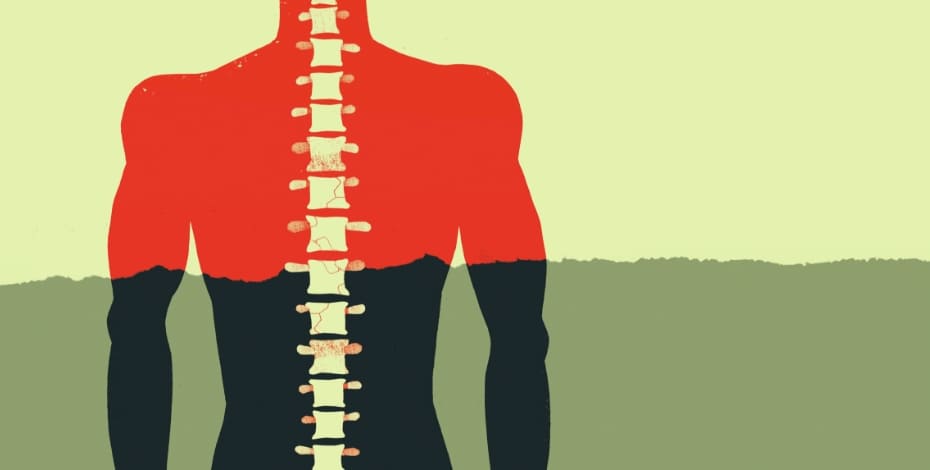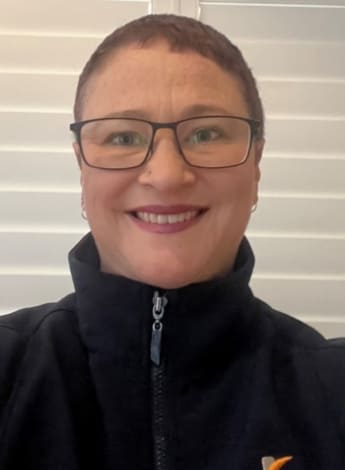
Finding consensus: guiding physiotherapy for people with spinal cord injury

Australian and New Zealand spinal cord injury physiotherapists have a new tool to ensure that best practice care is followed with the introduction of a comprehensive set of clinical practice guidelines for physiotherapy management. Here we look at the guidelines, how they were developed and how they are being used by physiotherapists around Australia.
Spinal cord injuries (SCI) are complex injuries that affect almost every aspect of a person’s life.
Physiotherapists play a key role in managing SCI, from acute care in hospital to rehabilitation and long- term care and management.
It’s complicated by the fact that every SCI is different and each person has their own individual needs.

Associate Professor Joanne Glinksy says every SCI has a different presentation.
‘Every different level and type of spinal cord injury has a different clinical presentation,’ says Associate Professor Joanne Glinsky APAM from the John Walsh Centre for Rehabilitation Research at the University of Sydney’s Kolling Institute.
Joanne and John Walsh Centre colleague Professor Lisa Harvey APAM—both physiotherapists, with decades of experience in SCI rehabilitation between them—have been talking about the need for guidelines on SCI management for more than 10 years.
In 2019, they finally got the ball rolling to start the process of developing them, with some funding from icare (New South Wales’ insurance scheme).
‘We thought it would be useful to put all of the evidence about physiotherapy interventions for people with spinal cord injury together in one place and to get the opinions of multiple experts and stakeholders,’ says Joanne.
Launched at the end of 2022 after three years of development by a team of experts led by Joanne and Lisa, the Australian and New Zealand Clinical Practice Guidelines for the physiotherapy management of people with Spinal Cord Injury are available on the SCI Physiotherapy Guidelines website, along with supporting information and clinical notes for both clinicians and consumers—people with SCI and their carers.
Funding support for the development of the guidelines was received from most of the state insurance and care schemes—including icare (New South Wales), the Transport Accident Commission (Victoria), the National Injury Insurance Scheme (Queensland), and the Lifetime Support Authority (South Australia)—and they were reviewed by many physiotherapists and academics across Australia.
Developing the guidelines
The guidelines consist of 19 overall principles of physiotherapy management (see table on page 43) and a further 79 recommendations and consensus statements for physiotherapy interventions, classified into 12 categories:
- lung volume or respiratory muscle strength
- cough and secretion clearance
- postural hypotension
- motor skills
- pain
- shoulder subluxation
- joint mobility
- spasticity
- bone mineral density
- swelling
- strength
- cardiorespiratory fitness and cardiovascular health.

Professor Lisa Harvey
For each recommendation, the available evidence has been closely examined by a panel of experts in SCI rehabilitation, management and respiratory care (the guidelines development committee), with members drawn from SCI units across Australia and New Zealand as well as physiotherapists in the community, academics and consumers.
The process started with identifying 100 PICO (participant, intervention, comparison, outcome) questions that the committee believed were important, such as ‘respiratory muscle training v no intervention on respiratory muscle strength in people with SCI who have respiratory muscle weakness’ and ‘hand function training v no intervention to improve hand function in people with tetraplegia’.
Each PICO question was then rigorously analysed through a systematic review of the evidence and subsequent consideration of benefits and harms, values and preferences, resource use, equity, accessibility and feasibility.
For some questions, there was enough evidence in the form of randomised controlled trials to make an evidence- based recommendation.
For those with insufficient or poor evidence, a consensus recommendation was developed for or against the intervention.
Both the evidence-based and consensus recommendations were graded as strong or weak and as for and against.
In total, the guidelines development committee made 14 recommendations based on evidence (12 weak evidence for, two weak evidence against) and 79 recommendations reached through consensus (45 strong consensus for, including the 19 overall principles; 29 weak consensus for; three strong consensus against; two weak consensus against).
For four of the PICO questions, no recommendation could be made due to lack of evidence and lack of consensus.
‘If we just said, “There’s only evidence for 10 of those 100 PICO questions; we’re not going to tell you what to do with anything else”, that wouldn’t have been useful, so where we didn’t have evidence, we wanted to provide an opinion from the room,’ Joanne explains.
Surprisingly, none of the evidence-based recommendations was graded as having strong evidence in favour of the intervention and only 12 had weak evidence for the intervention.
‘It is disappointing that with the current evidence the committee wasn’t able to make any strong recommendations.
‘At the moment, due to the evidence, weak recommendations are the best we have.
‘A weak recommendation for is still a recommendation to do the intervention,’ says Joanne.
The full guidelines have been published both directly on the website and as a downloadable document—Australian and New Zealand Clinical Practice Guidelines for the physiotherapy management of people with Spinal Cord Injury.
Each recommendation is listed alongside detailed descriptions of the evidence and reasoning behind it as well as a plain language summary.
A full outline of the methodology used to generate the guidelines is also provided.
‘The process needed to be clear and transparent to consumers and clinicians.
‘This is important for users to have confidence in the end product,’ says Joanne.
The guidelines in practice
Since the guidelines were published at the end of 2022, Joanne, Lisa and SCI colleagues across Australia have been presenting them to clinicians and academics around Australia, training clinicians in their use and seeking feedback on the guidelines and their implementation.
‘When we were finished, we put the guidelines out for review far and wide and listened to all of the feedback.
The guidelines were generally well received because we had involved a lot of people from the start of the process,’ Joanne says.
Overall, the guidelines have served to confirm best practice in SCI units and rehabilitation facilities across Australia, while at the same time raising awareness of some interventions that are less commonly used but are supported by a good evidence base.
Joanne and Lisa have been working with SCI services to implement the recommendations.
It’s a collaborative process, Joanne says.
‘There are some interventions in the guidelines, like inspiratory muscle training, which has quite good evidence.
‘We’re working with the units to identify the areas where physios don’t necessarily implement these recommendations currently and working on ways to get physios to prioritise them as part of treatment.
‘It’s about prioritising the interventions that are the most evidence-based,’ she says.
‘But you don’t really need to improve on the care in spinal cord injury units in Australia; it’s already best quality care.’

Alexia Matthews uses the SCI guidelines regularly in her work with clients of the Hunter Spinal Cord Injury Service.
Alexia Matthews APAM is a physiotherapist at the Hunter Spinal Cord Injury Service, a community-based multidisciplinary outreach service that primarily works with clients who have had a SCI within the past five years or so as well as those who are at risk of being hospitalised due to complications, such as pressure injuries or a health issue that could affect or be affected by their SCI.
A clinician with a couple of decades of experience in rehabilitation, and the last eight years working at a community clinic with SCI patients, Alexia was involved with some of the early conversations and research underpinning the development of the guidelines.
‘They have been fabulous.
‘We’ve been excited about getting them for quite a while,’ Alexia says.
‘The main thing that we were hoping to get out of the guidelines—and I feel that we have—is support for the things we’re already doing.
It was quite heartening to know that the stuff that we’re doing, which we’ve always done, is supported by those guidelines.’
She notes that, for example, the evidence shows that gait training does not have to involve high-tech robotics.
Basic treadmills and overground training work just as well and are more likely to be offered in community-based rehabilitation programs.
‘Spinal cord injury is such a dramatic and traumatic change in someone’s life and clients are always looking for something—the next thing that might help them walk or research programs to join.
‘Programs like that are important but it’s good to be able to say “You spent a week doing robotic stuff and that’s great but what we’re doing here is also really important to helping you achieve your goals”,’ Alexia says.
At Sydney’s Royal Rehab, Lyndall Katte is another fan of the guidelines.
Lyndall is a physiotherapist with more than two decades of experience in SCI.
At Royal Rehab she practises within the organisation’s public rehabilitation spinal cord services, working with patients who have been discharged from inpatient rehabilitation units at Royal North Shore Hospital, Prince of Wales Hospital or Royal Rehab’s own inpatient facility.
In addition to seeing patients based in Sydney and surrounding areas, she also regularly travels to rural locations around New South Wales, working both with clients and with their local clinicians.
‘The guidelines provide a one-stop shop.

Lyndall Katte says the guidelines are a one-stop shop for physios working with clients with SCI
‘Even as an experienced physio, I can refer to the guidelines to make sure that my recommendations are current.
‘And it’s not just a one-line recommendation—it’s layered—so I can see the evidence for and against a particular treatment or therapy and the process taken to make a particular recommendation,’ Lyndall says.
‘If I’m making a decision about a therapy I want to implement with someone or communicating that to a client or their family or training other physios, which is quite a big part of my role, I can actually take a screenshot of the guidelines on a particular intervention and communicate that to the team or the client.’
Lyndall says she refers to the guidelines frequently, whether it’s to double-check that she is following best practice, to find out more about a technique or intervention that she doesn’t often use or to provide recommendations to patients and other clinicians on whether a particular intervention is right for them.
She says that the comprehensive and systematic approach taken by the guidelines team reinforces the use of more rigorously tested interventions, such as inspiratory muscle training, and discourages the use of ‘faddish’ treatments like whole-body vibration, for which there is insufficient evidence to make a recommendation.
One surprise for Lyndall was the lack of strong evidence available, even for interventions that have quite a lot of research supporting them, such as strength training and stretching.
She says that part of the problem lies in the low numbers of patients—around 350–400 people sustain a SCI each year in Australia and every person has a different injury profile, making large randomised controlled clinical trials difficult.

Rehabilitation physio Karina Hawkins says the guidelines are her first port of call for best practice.
Lyndall’s colleague Karina Hawkins APAM is Senior Physiotherapist and Team leader of the Private Inpatient Rehabilitation Unit at Royal Rehab, which does double duty as an SCI unit alongside the organisation’s main inpatient SCI unit, one of the two specialist inpatient units for patients with SCI in New South Wales.
For Karina, the guidelines are a frequently accessed resource and her first port of call when she is looking for information and evidence on a particular intervention or therapy.
‘When I’m with a client and I’m not 100 per cent sure what the next steps should be, or I want to check that what I am recommending and implementing is best practice, I always look to the guidelines.
‘It saves me a lot of time as an inpatient therapist and gives me confidence and reassurance that I am doing the best for my clients,’ she says.
Next steps
The guidelines will be updated in the future as new evidence is generated in clinical trials, says Joanne.
And because the guidelines are the first to be developed specifically for use in physiotherapy management of SCI, there is plenty of international interest in them.
Joanne says she and Lisa hope that the Australian guidelines will lead to collaborations on international guidelines.
‘It is difficult to write a guideline internationally because some countries are well resourced and some countries are low resourced for rehabilitation.
‘In places where physiotherapy and rehabilitation are widely carried out, it’s easy to collaborate but in countries where there’s less access, physiotherapy and services are provided in different ways, it’s more difficult.
‘Creating worldwide guidelines is a good aspiration but you have to think about how different countries are resourced,’ she says.
In the meantime, Joanne and Lisa hope that the lack of robust evidence for many of the recommendations will spur researchers on to fill the gaps.
For many areas of SCI research, high-quality randomised controlled trials have only been conducted relatively recently or haven’t yet been completed.
‘It’s shown us the importance of high-quality randomised controlled trials and it’s also shown where the important questions are and where the holes are.
‘So we’re directing our efforts at the moment towards research in areas such as intensive motor training—giving people as much motor training as we can and seeing if that affects their motor function after spinal cord injury,’ Joanne says.
The Australian and New Zealand Clinical Practice Guidelines for the physiotherapy management of people with Spinal Cord Injury can be found at sciptguide.com
Overall principles of physiotherapy management
The following 19 principles are opinion statements with strong (100 per cent) consensus.
- People with a newly acquired SCI should be managed by a multidisciplinary team including a physiotherapist within a specialised SCI unit.
- People with a newly acquired SCI should receive physiotherapy assessment and treatment for the management of their impairments, activity limitations, and participation restrictions.
- People with a newly acquired SCI should receive physiotherapy services throughout their acute and rehabilitation phases.
- People with newly acquired SCI with respiratory muscle weakness should be assessed by a physiotherapist within 24 hours of admission to hospital.
- People with existing SCI admitted for the management of a respiratory condition should be assessed by a physiotherapist within 24 hours of admission to hospital.
- People with SCI should only receive physiotherapy by a registered physiotherapist or a delegate. People with SCI should receive physiotherapy treatments that are individualised and account for any general or specific precautions and contraindications relevant to the individual.
- People with SCI should be informed about all the relevant risks and benefits of different physiotherapy interventions.
- People with SCI should receive person-centred care.
- People with SCI should be empowered to manage their injuries including managing their physical rehabilitation and physical function.
- People with SCI should have the opportunity to participate in setting goals for their physiotherapy sessions that are SMART, collaborative, and regularly reviewed.
- People with SCI who are prescribed exercises should be provided with a hard or electronic copy of their individualised exercise programs.
- People with SCI should be assessed by a multidisciplinary team (that includes a physiotherapist) as appropriate to manage spasticity.
- People with SCI should be assessed by a multidisciplinary team (that includes a physiotherapist) as appropriate to prevent and treat pressure injuries.
- People with tetraplegia should be assessed by a multidisciplinary team (that includes a physiotherapist) as appropriate to determine suitability for upper limb reconstructive surgery.
- People with SCI should be assessed by a physiotherapist as appropriate throughout their lives.
- People with SCI should have physiotherapy treatment appropriate for the management of impairments, activity limitations or participation restrictions throughout their lives.
- People with SCI and respiratory muscle weakness who are at high risk of respiratory complications should have a respiratory management plan in place when discharged into the community from hospital (including education to the care team on appropriate interventions).
- People with SCI should receive appropriate equipment to maximise their independence, community participation or physical activity.
© Copyright 2025 by Australian Physiotherapy Association. All rights reserved.





